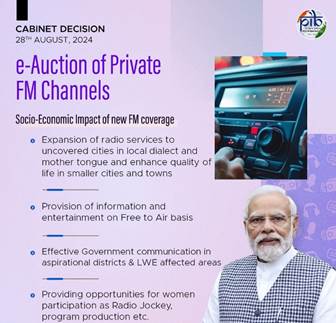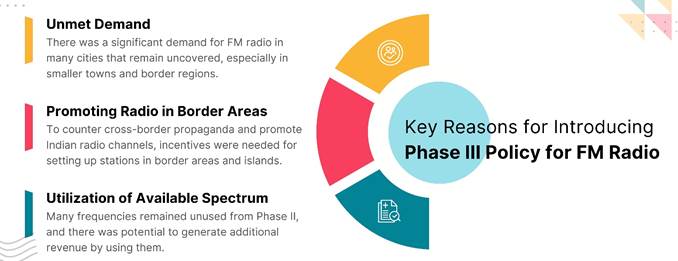Ministry of Information & Broadcasting
Expansion of Private FM Radio to 234 New Cities
Enhancing Local Content and Employment
Posted On: 28 AUG 2024 6:36PM
 The Union Cabinet, chaired by Prime Minister Narendra Modi, has approved a significant expansion of the Private FM Radio network across 234 new cities/towns in India. This decision is a part of the third batch of the Phase III FM Radio Policy, aimed at enhancing local content, creating new employment opportunities, and strengthening the government’s outreach, especially in underserved regions. The rollout involves the introduction of 730 new FM channels in 234 new cities with an estimated reserve price of ₹784.87 crore.
The Union Cabinet, chaired by Prime Minister Narendra Modi, has approved a significant expansion of the Private FM Radio network across 234 new cities/towns in India. This decision is a part of the third batch of the Phase III FM Radio Policy, aimed at enhancing local content, creating new employment opportunities, and strengthening the government’s outreach, especially in underserved regions. The rollout involves the introduction of 730 new FM channels in 234 new cities with an estimated reserve price of ₹784.87 crore.
Under the approved plan, the government will implement an ascending e-auction process for the new channels. An important aspect of this decision is the setting of the Annual License Fee (ALF) for FM channels at 4% of the gross revenue, excluding Goods and Services Tax (GST). This revised fee structure will apply to the new cities and towns being brought under the FM Phase III Policy.
The expansion is expected to fulfill the unmet demand for FM radio in cities and towns that currently lack such services, providing a platform for local content in native languages. It will also generate employment opportunities, particularly in aspirational districts and LWE-affected areas. Expanding FM Radio services aligns with the government’s ‘vocal for local’ initiatives, emphasising local dialects and cultures. The initiative aims to foster a sense of community and support local economies by providing a platform for regional content.


Benefits of Expansion of Private FM Radio Channels
 Enhanced Local Content: Promotes content in local languages and dialects, boosting cultural representation and "vocal for local" initiatives.
Enhanced Local Content: Promotes content in local languages and dialects, boosting cultural representation and "vocal for local" initiatives.
Employment Generation: Creates new job opportunities in these regions.
Improved Government Outreach: Strengthens government communication, especially in aspirational districts, LWE-affected areas, and border regions.
Unmet Demand Fulfilment: Satisfies the existing demand for FM radio in uncovered areas.

Background of Phase III FM Radio Policy
Phase III of the FM Radio Policy was introduced to expand private FM radio broadcasting to cover more cities, especially those that remained uncovered in previous phases. The first two phases had limited reach, covering only cities with a population of over three lakh and some state capitals. Despite the growth of the FM radio industry in Phase II, Border areas, particularly in J&K, NE States and Island territories, were largely missing from the FM map. The key reasons for introducing Phase II Policy are as follows:

Furthermore, a few of the Salient Features of the Phase III FM Radio Policy are as follows:
- News Content
Private FM stations can broadcast news bulletins from All India Radio (AIR) in an unaltered form. However, specific content, such as sports updates, weather, cultural events, career counselling, public announcements, etc., is classified as non-news and is permissible for private broadcasters.
- Ownership and Channel Limits
Private operators have been allowed to own more than one channel but not more than 40% of the total channels in a city, ensuring at least three different operators in a city.
- Networking of Channels
Private broadcasters are now allowed to network their channels across the country, unlike the previous restriction that allowed networking only within specific cities.
- Choice of Construction Agency
A choice is proposed to be given to the private FM broadcasters to choose any agency other than Broadcast Engineering Consultants India Limited (BECIL) for the construction of Common Transmission Infrastructure (CTI) within a period of 3 months. If no choice is made within three months, BECIL will be the default integrator.
With the expansion of Private FM Radio to 234 new cities/towns, the government aims to make radio a key tool for regional engagement, fostering local culture, and enhancing communication across the country. The decision reflects a commitment to democratising access to media, empowering local communities, and supporting India's diverse linguistic and cultural landscape. The rollout is anticipated to position FM Radio as a cornerstone of India's local connectivity and information dissemination.
References
Click here to see in PDF (0.74 MB, Format: PDF)
Santosh Kumar/ /Ritu Kataria/Apoorva Mahiwal
(Backgrounder ID: 152059)
Visitor Counter : 11